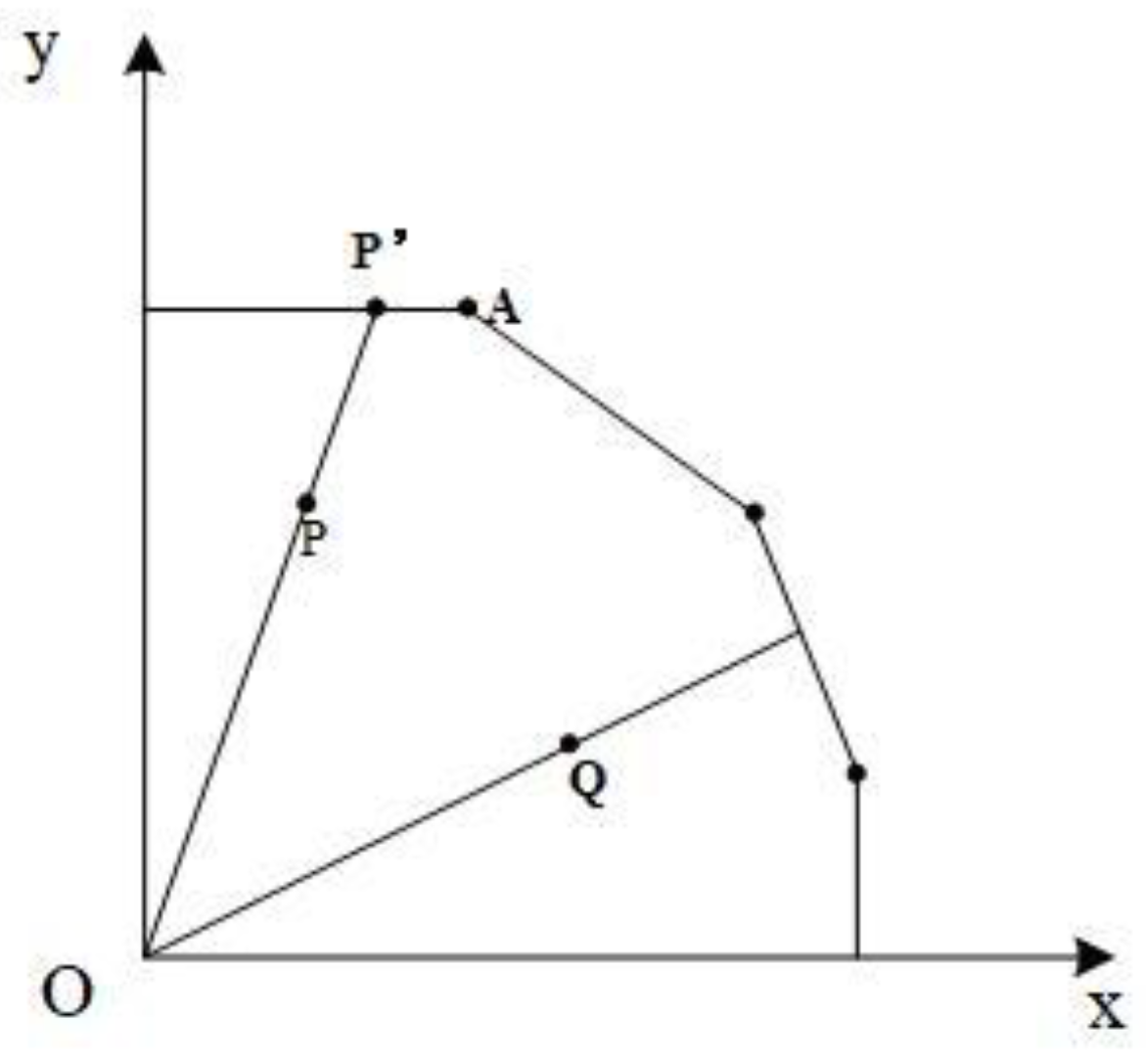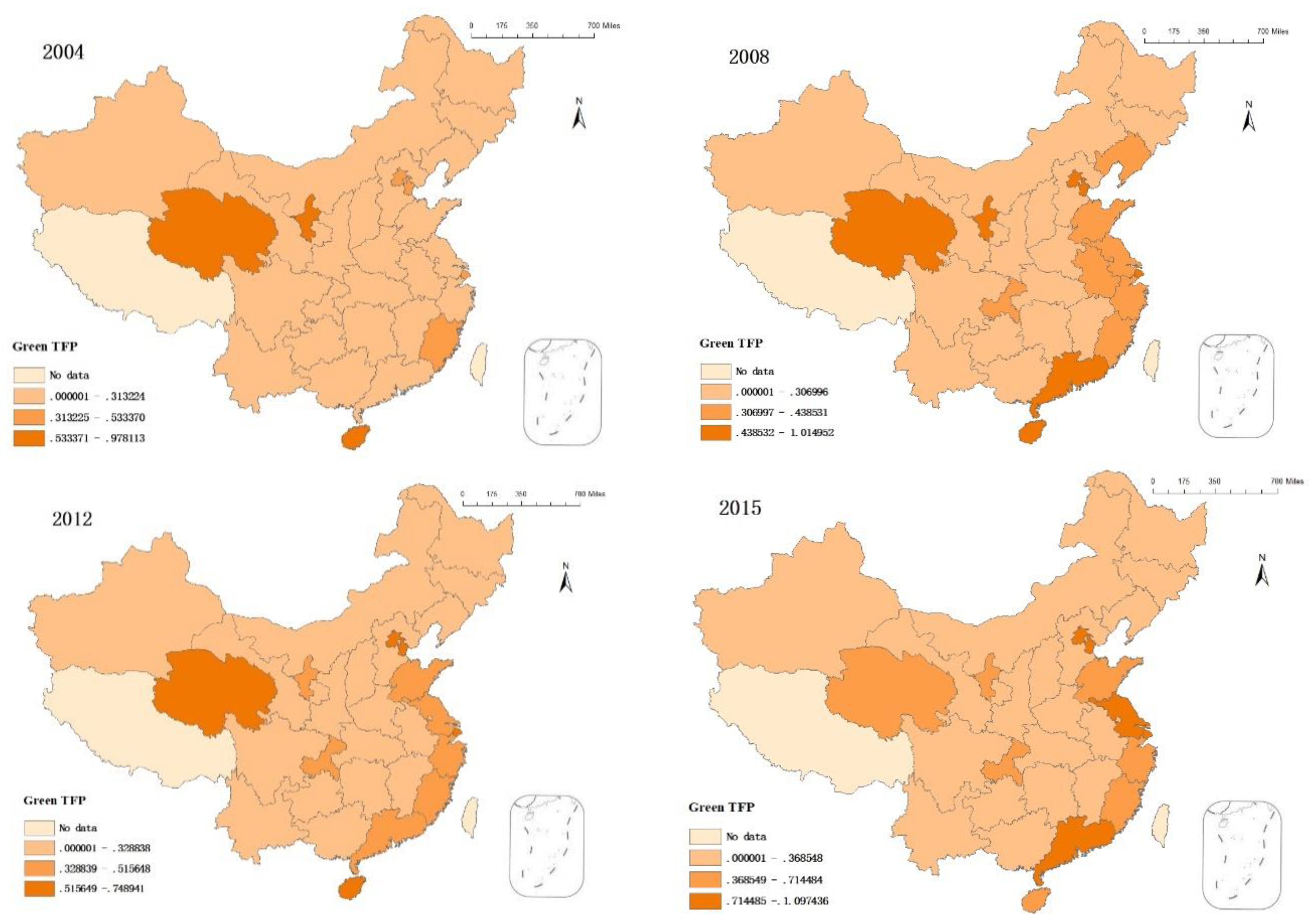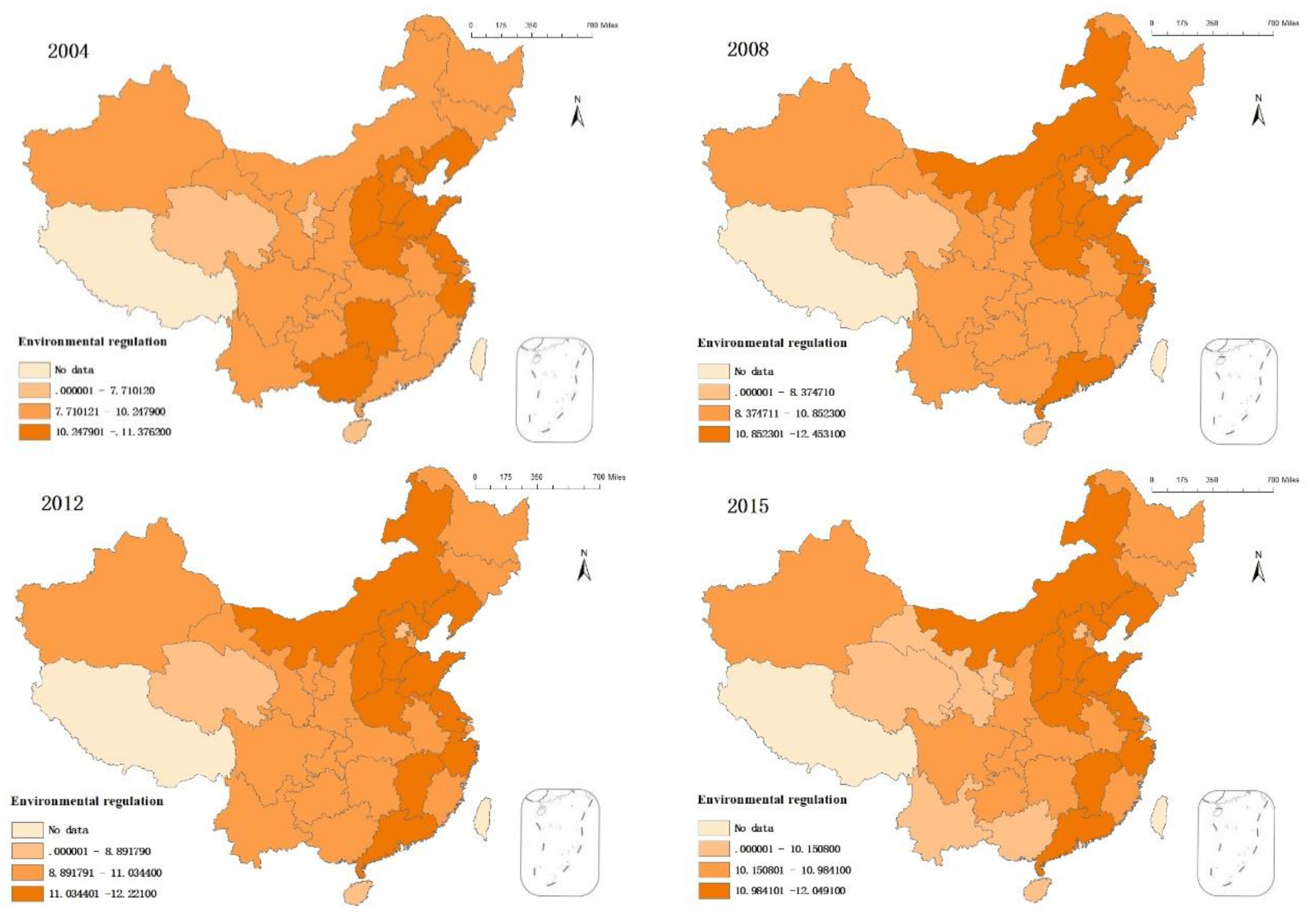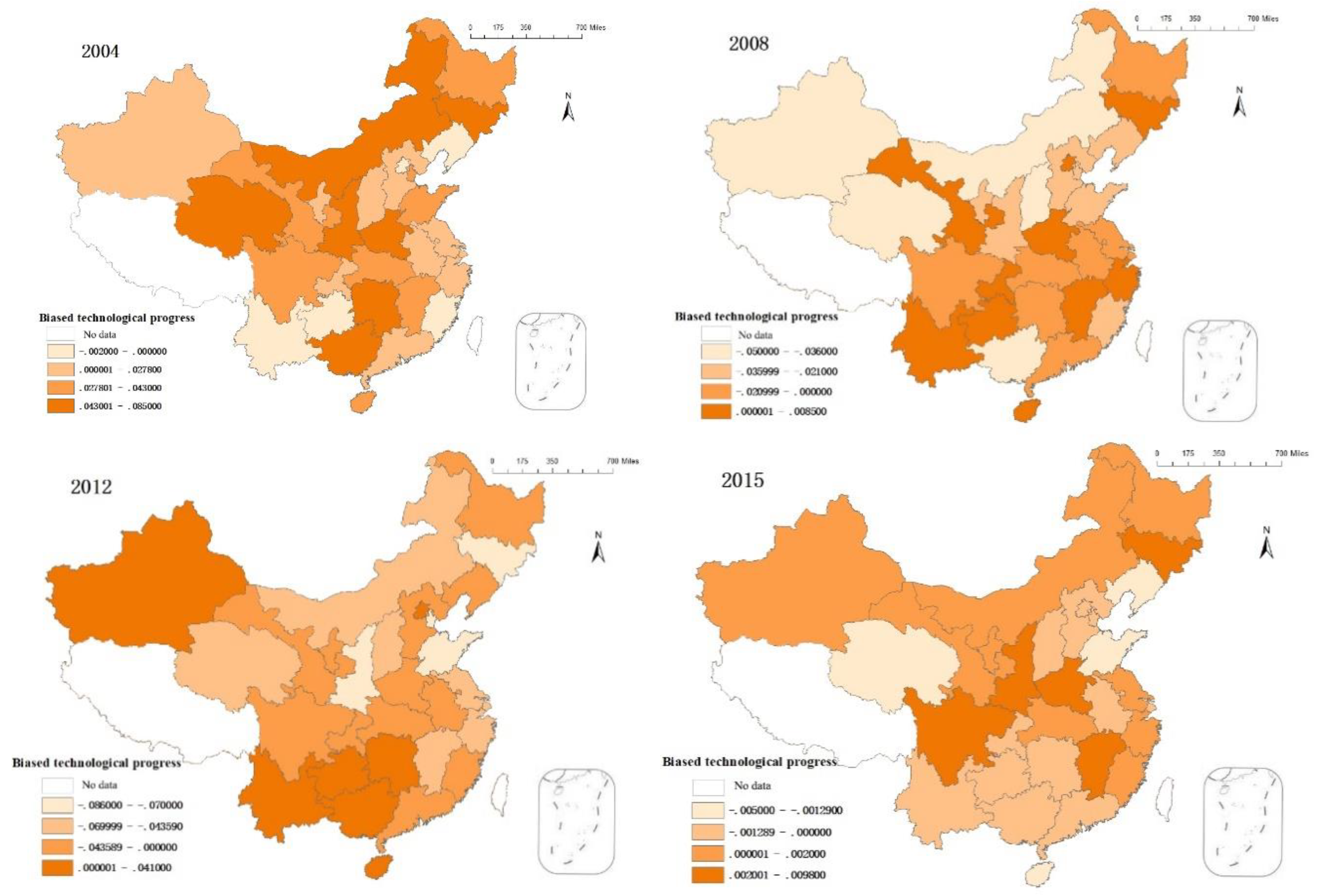Going Green or Going Away? A Spatial Empirical Examination of the Relationship between Environmental Regulations, Biased Technological Progress, and Green Total Factor Productivity
Abstract
1. Introduction
2. Literature Review
- Technological progress is directional. This study therefore used the standardized supply surface system method to calculate biased technological progress. This method is very reliable. The algorithm also considers the sufficiency and insufficiency of elements under environmental constraints and can be used to obtain the technological progress deviation more accurately while factors are abundant and insufficient.
- The Porter hypothesis suggests that appropriate environmental regulations will promote enterprise innovations. This study adds the product of technological progress and environmental regulation to the model to explore the effect of environmental regulation on green total factor productivity under the influence of technological advancement.
- Technological progress has a spatial diffusion effect, and the formulation of environmental regulation policies in various provinces and cities will also be affected by neighboring provinces. The spatial Durbin model can examine the influence of the dependent variables affected by the variables in the local area, as well as the dependent and independent variables in neighboring areas. Therefore, this paper will focus on the spatial relationship between technological progress, environmental regulation, and green total factor productivity.
3. Methodology and Data
3.1. Green Total Factor Productivity (GTFP) Measurement
3.1.1. SBM Directional Distance Function
3.1.2. DDF and GML Productivity Index
3.2. Biased Technical Progress Measurement
3.2.1. The Direction of Technical Progress
3.2.2. Estimating Capital-Enhanced Technological Progress and Labor-Enhanced Technological Progress
3.2.3. Alternative Elasticity and Capital Intensity Estimation
3.3. Environmental Regulations
3.4. Spatial Durbin Model
3.5. Data and Variable Selection
4. Results Analysis
4.1. Analysis of GTFP Spatiotemporal Disparity
4.2. Alternative Elasticity and Capital Intensity Calculations
4.3. Measuring Biased Technological Progress
4.4. The Spatial Effects between Biased Technology Progress, Environmental Regulations, and Green TFP
5. Discussion
6. Conclusions
Author Contributions
Funding
Acknowledgments
Conflicts of Interest
References
- IEA (Inernational Energy Agency). World Energy Outlook 2010; Inernational Energy Agency: Paris, France, 2010. [Google Scholar]
- Song, M.; Wang, S. Environmental regulation, technological progress and economic growth. Econ. Res. 2013, 3, 122–134. [Google Scholar]
- Hailu, A.; Veeman, T.S. Environmentally sensitive productivity analysis of the Canadian pulp and paper industry, 1959–1994: An input distance function approach. J. Environ. Econ. Manag. 2000, 40, 251–274. [Google Scholar] [CrossRef]
- Dong, Z.; Cai, X.; Wang, L. The direction of technological progress, the scale of urban land use and environmental quality. Econ. Res. 2014, 49, 111–124. [Google Scholar]
- Xi, J. Winning a welloff society and seizing the new eraof Chinese characteristics Socialism great victory. China Daily, 28 October 2017. [Google Scholar]
- Färe, R.; Grosskopf, S. A Comment on Weak Disposability in Nonparametric Production Analysis. Am. J. Agric. Econ. 2009, 91, 535–538. [Google Scholar] [CrossRef]
- Fukuyama, H.; Weber, W.L. Estimating indirect allocative inefficiency and productivity change. J. Oper. Res. Soc. 2009, 60, 1594–1608. [Google Scholar] [CrossRef]
- Tone, K. A slacks-based measure of efficiency in data envelopment analysis. Eur. J. Oper. Res. 2001, 130, 498–509. [Google Scholar] [CrossRef]
- Chambers, R.G.; Färe, R.; Grosskopf, S. Productivity Growth in APEC Country. Pac. Econ. Rev. 1996, 1, 181–190. [Google Scholar] [CrossRef]
- Zhang, H.; Wei, X. Green paradox or reverse reduction–double effect of environmental regulation on carbon emissions. Chin. Popul. Resour. Environ. 2014, 24, 21–29. [Google Scholar]
- Yu, C.; Gao, H. The influence of environmental control on China’s environmental pollution—From the perspective of recessive economy. Chin. Ind. Econ. 2015, 7, 21–35. [Google Scholar]
- Yun, S.; Liu, Z. Environmental regulation, technological progress and China’s economic development—An empirical study based on correction data of DMSP/OLS night Light. Finan. Monogr. 2018, 1–10. [Google Scholar] [CrossRef]
- Acemoglu, D. Directed technical change. Rev. Econ. Stud. 2002, 69, 781–809. [Google Scholar] [CrossRef]
- Dai, T.; Xu, Y. The direction of China’s technological progress. World Econ. 2010, 11, 54–70. [Google Scholar]
- Jing, W.; Zhang, L. Environmental regulation, opening-up and the development of green technology in China’s industry. Econ. Res. 2014, 9, 34–47. [Google Scholar]
- Song, M.; Wang, S. Can employment structure promote environment-biased technical progress? Technol. Forecast. Soc. Chang. 2016, 112, 285–292. [Google Scholar] [CrossRef]
- Millimet, D.L.; Roy, S.; Sengupta, A. Environmental Regulations and Economic Activity: Influence on Market Structure. Ann. Rev. Resour. Econ. 2009, 1, 99–117. [Google Scholar] [CrossRef]
- Millimet, D.L.; Roy, J. Empirical Tests of the Pollution Haven Hypothesis When Environmental Regulation is Endogenous. J. Appl. Econ. 2016, 31, 623–645. [Google Scholar] [CrossRef]
- Sun, C.; Zhang, F.; Xu, M. Investigation of pollution haven hypothesis for China: An ARDL approach with breakpoint unit root tests. J. Clean. Prod. 2017, 161, 153–164. [Google Scholar] [CrossRef]
- Solarin, S.A.; Al-Mulali, U.; Musah, I.; Ozturk, I. Investigating the pollution haven hypothesis in Ghana: An empirical investigation. Energy 2017, 124, 706–719. [Google Scholar] [CrossRef]
- Porter, M.E.; Claas, V.D.L. Toward a New Conception of the Environment-Competitiveness Relationship. J. Econ. Perspect. 1995, 9, 97–118. [Google Scholar] [CrossRef]
- Ramanathan, R.; He, Q.; Black, A.; Ghobadian, A.; Gallear, D. Environmental regulations, innovation and firm performance: A revisit of the Porter hypothesis. J. Clean. Prod. 2016, 155, 79–92. [Google Scholar] [CrossRef]
- Xu, S. Environmental regulation and enterprise competitiveness—A query based on the “Porter hypothesis”. Int. Trade Issues 2007, 293, 78–83. [Google Scholar]
- Jin, Y. China’s industrial development under the constraint of resources and environment. Chin. Ind. Econ. 2005, 4, 5–14. [Google Scholar]
- Hu, J.; Wang, Z.; Lian, Y.; Huang, Q. Environmental Regulation, Foreign Direct Investment and Green Technological Progress-Evidence from Chinese Manufacturing Industries. Int. J. Environ. Res. Public Health 2018, 15, 221. [Google Scholar]
- Feng, Z.; Chen, W. Environmental Regulation, Green Innovation, and Industrial Green Development: An Empirical Analysis Based on the Spatial Durbin Model. Sustainability 2018, 10, 223. [Google Scholar] [CrossRef]
- Yu, Y.; Huang, J.; Luo, N. Can More Environmental Information Disclosure Lead to Higher Eco-Efficiency? Evidence from China. Sustainability 2018, 10, 528. [Google Scholar]
- Dong-hyun, O. A global Malmquist-Luenberger productivity index. J. Prod. Anal. 2010, 34, 183–197. [Google Scholar]
- Wang, B.; Zhu, N. Study on the efficiency and total factor productivity of Chinese listed commercial banks under the constraint of non-performing loans—An empirical analysis based on SBM directional distance function. Financ. Res. 2011, 1, 110–130. [Google Scholar]
- Färe, R.; Grosskopf, S.; Norris, M. Productivity Growth, Technical Progress, and Efficiency Change in Industrialized Countries: Reply. Am. Econ. Rev. 1997, 87, 1040–1044. [Google Scholar]
- Caves, D.W.; Christensen, L.R.; Diewert, W.E. The Economic Theory of Index Numbers and the Measurement of Input, Output, and Productivity. Econometrica 1982, 50, 1393–1414. [Google Scholar] [CrossRef]
- Chung, Y.H.; Färe, R.; Grosskopf, S. Productivity and Undesirable Outputs: A Directional Distance Function Approach. Microeconomics 1997, 51, 229–240. [Google Scholar] [CrossRef]
- David, P.A. Biased Efficiency Growth and Capital-Labor Substitution in the U.S. 1899–1960. Am. Econ. Rev. 1965, 55, 357–394. [Google Scholar]
- Klump, R.; Mcadam, P.; Willman, A. Factor Substitution and Factor-Augmenting Technical Progress in the United States: A Normalized Supply-Side System Approach. Rev. Econ. Stat. 2007, 89, 183–192. [Google Scholar] [CrossRef]
- León-Ledesma, M.A.; Mcadam, P.; Willman, A. Identifying the Elasticity of Substitution with Biased Technical Change. Work. Pap. 2009, 100, 1330–1357. [Google Scholar] [CrossRef]
- Chen, X.; Lian, Y.J. Capital-Labor substitution elasticity and regional economic growth—A test of the Dragrandeville hypothesis. Q. J. Econ. 2013, 1, 93–118. [Google Scholar]
- Böcher, M. A theoretical framework for explaining the choice of instruments in environmental policy. For. Policy Econ. 2012, 16, 14–22. [Google Scholar] [CrossRef]
- Fredriksson, P.G.; Millimet, D.L. Strategic Interaction and the Determination of Environmental Policy across U.S. States. J. Urban Econ. 2002, 51, 101–122. [Google Scholar] [CrossRef]
- Konisky, D.M. Inequities in Enforcement? Environmental Justice and Government Performance. J. Policy Anal. Manag. 2009, 28, 102–121. [Google Scholar] [CrossRef]
- Li, S.L.; Chu, S.B.; Shen, C. The competition of local governments, the environmental regulation and regional ecological efficiency. World Econ. 2014, 4, 88–110. (In Chinese) [Google Scholar]
- Zhang, W.B.; Zhang, L.F.; Zhang, K.Y. The competition form and evolution of China’ provincial environmental regulation intensity––Based on the analysis of a two-regime spatial Durbin model with fixed effects. Manag. World 2010, 12, 34–44. (In Chinese) [Google Scholar]
- Anselin, L. Lagrange multiplier test diagnostics for spatial dependence and spatial heterogeneity. Geogr. Anal. 1988, 20, 1–17. [Google Scholar] [CrossRef]
- LeSage, J.; Pace, R.K. Introduction to Spatial Econometrics; Chapman & Hall/CRC: Boca Raton, FL, USA, 2009. [Google Scholar]
- LeSage, J.P.; Pace, R.K. The biggest myth in spatial econometrics. Econometrics 2014, 2, 217–249. [Google Scholar] [CrossRef]
- Keller, W. Geographic Localization of International Technology Diffusion. Am. Econ. Rev. 2002, 92, 120–142. [Google Scholar] [CrossRef]
- Liu, Q.; Zhang, Y.; Li, S. Spatio-temporal differentiation of manufacturing industry in Shandong province based on Space Doberman model. Geogr. Sci. 2017, 5, 691–700. [Google Scholar]
- Costanza, R.; d’Arge, R.; de Groot, R.; Farber, S.; Grasso, M.; Hannon, B.; Limburg, K.; Naeem, S.; O’Neill, R.V.; Paruelo, J.; et al. The value of the world’s ecosystem services and natural capital. Nature 1997, 387, 253–260. [Google Scholar] [CrossRef]
- Sun, C.; Wang, S.; Zou, W. Chinese marine ecosystem services value: Regional and structural equilibrium analysis. Ocean Coast. Manag. 2016, 125, 70–83. [Google Scholar] [CrossRef]
- Shan, H. Re-estimate of the capital stock K in China: 1952–2006 years. Quant. Econ. Technol. Econ. Stud. 2008, 10, 17–31. [Google Scholar]
- Acemoglu, D.; Zilibotti, F. Productivity Differences. Q. J. Econ. 2001, 116, 563–606. [Google Scholar] [CrossRef]
- Zhong, Z. Factor substitution elasticity, technological progress bias and China’s industrial industry economic growth. Contemp. Econ. Sci. 2014, 36, 74–81. [Google Scholar]
- Deng, J.; Liu, Y. Industrial agglomeration, spatial spillover and regional economic growth—Based on the space panel Doberman model. Econ. Quest. 2016, 1, 66–76. [Google Scholar]




| Models | Variable | Unit | Obs. | Mean | Std. Dev. | Min | Max | |
|---|---|---|---|---|---|---|---|---|
| SBM–Malmquist–Global–Luenberger | Desired output | Green GDP | 100 million RMB | 390 | 6186.533 | 5676.814 | 86.1691 | 31,371.63 |
| Undesired output | So2 | 104 tons | 390 | 74.1728 | 44.0951 | 2.2 | 200.3 | |
| Input | Capital stock | 100 million RMB | 390 | 10,393.95 | 8165.99 | 952.971 | 57,530.79 | |
| Labor | 104 persons | 390 | 4402.097 | 2647.705 | 534 | 10,849 | ||
| Total energy consumption | 10,000 tce | 390 | 11,711.57 | 7761.036 | 684 | 38,899 | ||
| Spatial Durbin Model | - | GTFP | - | 360 | 0.393 | 0.225 | 0.151 | 1.131093 |
| Educ | Natural logarithm | 360 | 8.534 | 0.917 | 5.704 | 10.43347 | ||
| FDI | % | 360 | 2.392 | 1.948 | 0.028 | 11.80942 | ||
| Indus | % | 360 | 47.557 | 7.915 | 19.3 | 61.5 | ||
| Paiwu | Natural logarithm | 360 | 10.551 | 0.994 | 7.354 | 12.53128 | ||
| Techg | - | 360 | 0.0026 | 0.030 | −0.36 | 0.128 |
| Provinces | (1) | (2) | (3) | (4) | (5) | (6) | (7) |
|---|---|---|---|---|---|---|---|
| Beijing | 1.020 *** | 0.999 *** | 0.492 *** | −2.600 *** | 0.354 *** | 2.686 *** | 0.362 *** |
| Tianjin | 1.014 *** | 0.947 *** | 0.502 *** | −0.086 *** | 1.800 *** | 0.099 *** | 1.494 *** |
| Hebei | 1.012 *** | 0.988 *** | 0.495 *** | −0.210 ** | 1.151 *** | 0.221 *** | 1.082 *** |
| Shanxi | 1.022 *** | 0.957 *** | 0.499 *** | −0.086 *** | 1.555 *** | 0.093 *** | 1.157 *** |
| Inner Mongolia | 1.009 *** | 0.661 *** | 0.498 *** | 0.009 *** | 0.207 *** | 0.013 *** | 1.298 ** |
| Liaoning | 1.008 *** | 0.890 *** | 0.494 *** | −0.002 | 4.026 | 0.017 *** | 0.728 *** |
| Jilin | 1.002 *** | 0.653 *** | 0.496 *** | 0.010 *** | 0.286 *** | 0.003 | 2.254 |
| Heilongjiang | 1.016 *** | 0.944 *** | 0.501 *** | −0.063 *** | 2.121 *** | 0.082 *** | 1.576 *** |
| Shanghai | 1.010 *** | 0.940 *** | 0.501 *** | −0.056 *** | 1.818 *** | 0.065 *** | 1.483 *** |
| Jiangsu | 1.000 *** | 0.719 *** | 0.497 *** | 0.003 * | 0.202 | 0.009 *** | 1.427 *** |
| Zhejiang | 0.997 *** | 0.691 *** | 0.498 *** | 0.001 | 0.108 | 0.007 *** | 1.427 *** |
| Anhui | 1.007 *** | 0.839 *** | 0.491 *** | 0.003 | 0.136 | 0.005 ** | 1.274 |
| Fujian | 1.001 *** | 0.901 *** | 0.493 *** | −0.001 | 1.141 | 0.008 ** | 0.897 |
| Jiangxi | 1.001 *** | 0.749 *** | 0.494 *** | 0.003 | 0.105 | 0.006 * | 2.674 |
| Shandong | 1.003 *** | 0.625 *** | 0.500 *** | 0.002 | 0.100 | 0.006 *** | 1.160 ** |
| Henan | 1.010 *** | 0.669 *** | 0.493 *** | 0.005 *** | 0.174 *** | -0.002 | 3.129 |
| Hubei | 1.003 *** | 0.753 *** | 0.494 *** | 0.008 *** | 0.273 *** | 0.004 | 1.942 |
| Hunan | 1.013 *** | 0.801 *** | 0.491 *** | 0.011 *** | 0.254 *** | 0.004 | 1.324 |
| Guangdong | 1.020 *** | 0.971 *** | 0.497 *** | −0.085 *** | 1.579 *** | 0.092 *** | 1.231 *** |
| Guangxi | 1.005 *** | 0.886 *** | 0.491 *** | 0.019 *** | 0.221 *** | -0.001 | 0.002 |
| Hainan | 1.002 *** | 0.948 *** | 0.487 *** | 0.010 | 0.104 | -0.006 | 0.074 |
| Chongqing | 1.011 *** | 0.957 *** | 0.489 *** | 0.004 | 0.488 | 0.025 *** | 0.698 * |
| Sichuan | 1.008 *** | 0.798 *** | 0.493 *** | 0.009 *** | 0.269 *** | 0.007 *** | 1.435 |
| Guizhou | 1.017 *** | 0.998 *** | 0.490 *** | 0.068 | 0.926 | -0.056 | 1.456 |
| Yunnan | 1.013 *** | 0.997 *** | 0.490 *** | 0.102 | 1.087 *** | -0.107 | 1.296 *** |
| Shanxi | 1.005 *** | 0.698 *** | 0.497 *** | 0.007 *** | 0.207 *** | 0.008 *** | 1.488 |
| Gansu | 1.006 *** | 0.817 *** | 0.492 *** | 0.001 | 0.027 | 0.015 *** | 0.665 ** |
| Qinghai | 1.008 *** | 0.726 *** | 0.485 *** | 0.011 *** | 0.357 *** | 0.008 *** | 1.097 |
| Ningxia | 1.022 *** | 0.985 *** | 0.486 *** | 0.033 | 0.086 *** | −12.543 | 2.861 *** |
| Xinjiang | 1.004*** | 0.967 *** | 0.489*** | 0.003 | 0.203 | 0.002 | 0.275 |
| Observations | 13 | 13 | 13 | 13 | 13 | 13 | 13 |
| Year | 2004 | 2005 | 2006 | 2007 | 2008 | 2009 |
| D > 0 | 28 | 28 | 24 | 19 | 3 | 3 |
| D < 0 | 2 | 2 | 6 | 11 | 27 | 27 |
| Year | 2010 | 2011 | 2012 | 2013 | 2014 | 2015 |
| D > 0 | 23 | 20 | 6 | 27 | 27 | 27 |
| D < 0 | 7 | 10 | 24 | 3 | 3 | 3 |
| Variables | (1) | (2) | (3) | (4) | (5) |
|---|---|---|---|---|---|
| Main | Wx. | Direct | Indirect | Total | |
| tec. | −0.169 | −36.59 ** | −0.251 | −0.567 * | −0.818 * |
| (−0.81) | (−1.97) | (−1.09) | (−1.91) | (−1.89) | |
| −0.0167 | −1.212 | −0.0208 | −0.0211 | −0.0419 * | |
| (−0.94) | (−1.34) | (−1.17) | (−1.43) | (−1.65) | |
| 0.0218 *** | 1.549 ** | 0.0264 *** | 0.0266 *** | 0.0530 *** | |
| (3.55) | (2.51) | (4.14) | (2.87) | (4.03) | |
| 0.371 * | 14.59 | −0.00167 | 0.00398 *** | 0.00231 | |
| (1.74) | (0.53) | (−1.31) | (2.60) | (1.06) | |
| indus. | −0.00230 * | 0.269 *** | −0.00423 | −0.0164 ** | −0.0207 * |
| (−1.84) | (2.95) | (−0.74) | (−2.04) | (−1.74) | |
| fdid | −0.00163 | −1.015 ** | 0.235 *** | −0.0000829 | 0.235 *** |
| (-0.30) | (-1.97) | (8.59) | (−0.01) | (7.13) | |
| educ. | 0.233 *** | −1.938 *** | 0.408 * | 0.251 | 0.659 |
| (8.50) | (−3.14) | (1.74) | (0.61) | (1.20) | |
| cons. | −1.488 *** | ||||
| (−5.56) | |||||
| spatial rho. | 7.956 *** | ||||
| (3.32) | |||||
| variance lgt_theta | −2.287 *** | ||||
| (−13.02) | |||||
| sigma2_e | 0.00801 *** | ||||
| (12.49) | |||||
| Hausman | −96.43 | ||||
| adjusted R2 | 0.3225 | ||||
| log likelihood | 372.879 | ||||
© 2018 by the authors. Licensee MDPI, Basel, Switzerland. This article is an open access article distributed under the terms and conditions of the Creative Commons Attribution (CC BY) license (http://creativecommons.org/licenses/by/4.0/).
Share and Cite
Wang, X.; Sun, C.; Wang, S.; Zhang, Z.; Zou, W. Going Green or Going Away? A Spatial Empirical Examination of the Relationship between Environmental Regulations, Biased Technological Progress, and Green Total Factor Productivity. Int. J. Environ. Res. Public Health 2018, 15, 1917. https://doi.org/10.3390/ijerph15091917
Wang X, Sun C, Wang S, Zhang Z, Zou W. Going Green or Going Away? A Spatial Empirical Examination of the Relationship between Environmental Regulations, Biased Technological Progress, and Green Total Factor Productivity. International Journal of Environmental Research and Public Health. 2018; 15(9):1917. https://doi.org/10.3390/ijerph15091917
Chicago/Turabian StyleWang, Xueli, Caizhi Sun, Song Wang, Zhixiong Zhang, and Wei Zou. 2018. "Going Green or Going Away? A Spatial Empirical Examination of the Relationship between Environmental Regulations, Biased Technological Progress, and Green Total Factor Productivity" International Journal of Environmental Research and Public Health 15, no. 9: 1917. https://doi.org/10.3390/ijerph15091917
APA StyleWang, X., Sun, C., Wang, S., Zhang, Z., & Zou, W. (2018). Going Green or Going Away? A Spatial Empirical Examination of the Relationship between Environmental Regulations, Biased Technological Progress, and Green Total Factor Productivity. International Journal of Environmental Research and Public Health, 15(9), 1917. https://doi.org/10.3390/ijerph15091917





